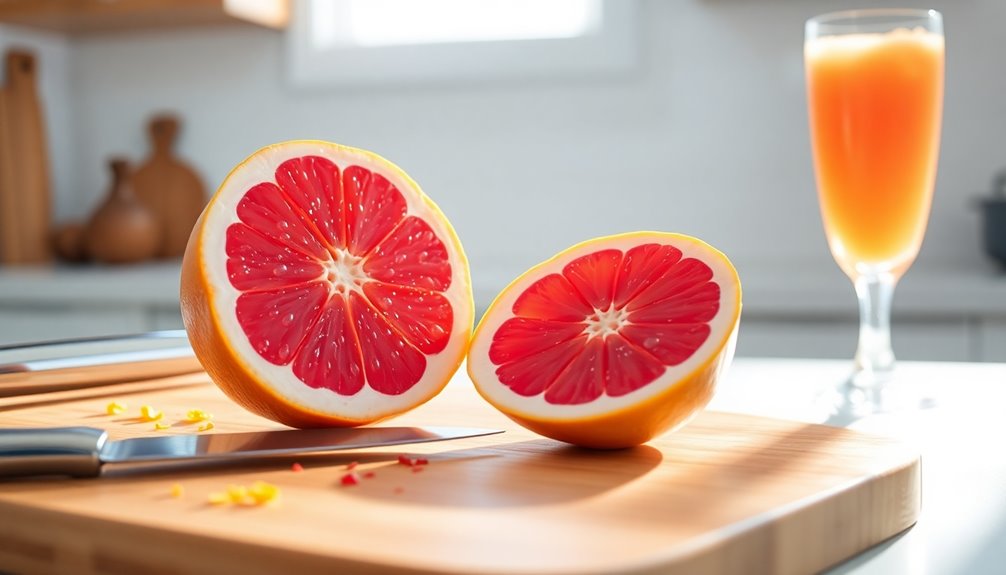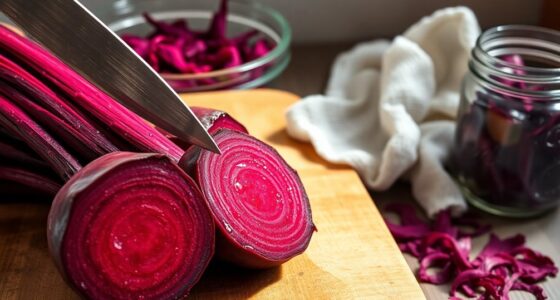To make grapefruit juice, start by peeling and chopping ripe grapefruit into smaller pieces. You can use a juicer, blender, or manual juicer. Simply feed the pieces into the juicer, blend them with a little water for about 60 seconds, or press and twist grapefruit halves with a manual juicer. Strain the juice if you want a smoother finish. Enjoy it fresh, and you can even sweeten it to taste. Discover more tips and variations to enhance your juice experience!
Key Takeaways
- Peel and chop ripe grapefruit into smaller pieces for easier juicing.
- Use a juicer, blender, or manual juicer to extract the juice.
- Strain the juice if a smoother texture is desired after blending.
- Sweeten the juice with honey, syrup, or sugar to taste, if needed.
- Enjoy fresh grapefruit juice for its vitamin C and refreshing flavor!

Making grapefruit juice is a refreshing way to enjoy the tangy flavor and health benefits of this citrus fruit. If you've ever tasted fresh grapefruit juice, you know it's a delightfully zesty experience that can brighten your morning. Plus, it's packed with vitamin C and antioxidants, providing a perfect boost to your immune system. So, let's dive into how you can make your own homemade grapefruit juice with ease.
To get started, you'll need a ripe grapefruit. Begin by peeling it and chopping it into smaller pieces that'll fit your juicer or blender. If you're using a juicer, simply feed those chopped grapefruit pieces into the machine. You'll collect the fresh juice in a container, ready to sip. This method is quick and allows you to enjoy the pure, tangy flavor of grapefruit without any fuss.
If you're using a blender instead, blend the grapefruit pieces with a little water for about 45 to 60 seconds. After blending, strain the mixture to remove pulp if you prefer a smoother juice. Both methods yield a deliciously fresh result.
For those who love the hands-on approach, you can opt for a manual juicing method. Slice the grapefruit in half and use a citrus juicer to press and twist each half to extract the juice. This technique gives you ultimate control over the juicing process, ensuring every drop of tangy goodness is captured. If you like your juice without pulp, remember to strain it afterward for a clean finish.
A typical serving of homemade grapefruit juice yields about 1 ¾ cups (420 ml), making it perfect for sharing or enjoying throughout the day. Besides its delightful taste, the health benefits of grapefruit are noteworthy. It’s not just a tasty drink; it’s a powerhouse of vitamins and minerals that can support your overall health. You might also consider adding a hint of ginger for an extra kick, enhancing both flavor and benefits. In addition to its refreshing flavor, the natural acidity of grapefruit juice can aid digestion and boost metabolism. For those interested in understanding what makes this beverage so nutritious, the grapefruit juice content explained shows that it is packed with vitamin C, antioxidants, and fiber, all contributing to its reputation as a health-boosting choice. Whether enjoyed on its own or mixed into a smoothie, grapefruit juice remains a delicious and beneficial addition to any diet.
Now, if you prefer your juice a bit sweeter, you can adjust the taste by adding a bit of honey, syrup, or sugar. Just remember to start with a small amount and adjust to your liking.
It's important to note that grapefruit can interact with certain medications, so if you're on any prescriptions, make sure to consult with your healthcare provider to avoid any complications.
Incorporating fresh grapefruit juice into your diet is an easy and tasty way to reap its health benefits. Whether you're enjoying it in the morning or as a midday refresher, this homemade juice is sure to invigorate your senses. So grab your grapefruit, juicer, or blender, and get ready to enjoy the vibrant tangy flavor of this delightful citrus drink. You'll be amazed at how simple it's to create your own fresh grapefruit juice right at home!
Frequently Asked Questions
What Is the Best Way to Juice a Grapefruit?
When you're looking to juice a grapefruit, the best method is to use a citrus juicer.
Start by slicing the grapefruit in half and press it down to extract maximum juice. If you want a smoother texture, consider blending the pieces first and then straining.
Just remember to remove the white pith and seeds beforehand, as they can make your juice bitter.
Enjoy your fresh, tangy grapefruit juice!
How Is Grapefruit Juice Made?
Grapefruit juice's glorious, tangy taste tantalizes your taste buds!
You'll peel and chop the grapefruit first, ensuring all that vibrant flavor is ready for extraction. If you're using a juicer, feed the pieces in and collect the juice. For a blender, blend with water, then strain away pulp. Hand juicing? Slice, press, and enjoy!
Just two medium grapefruits will yield about 1 ¾ cups of refreshing juice packed with vitamins.
Is Homemade Grapefruit Juice Good for You?
Yes, homemade grapefruit juice is good for you!
It's packed with antioxidants, vitamins, and minerals that boost your immune system and skin health. Plus, it's low in calories, helping with weight loss and liver detoxification.
Drinking it can lower cholesterol and reduce heart disease risk, making it a heart-healthy choice.
Just remember to check for any medication interactions, as grapefruit juice can affect how some drugs work.
Enjoy it fresh!
Is It OK to Drink Grapefruit Juice Everyday?
Imagine the sun-soaked citrus, vibrant and bursting with flavor. Drinking grapefruit juice every day can be beneficial, thanks to its vitamin C and antioxidants.
However, moderation's crucial; stick to 8 oz or less daily. If you're on medication, especially cholesterol drugs, it's essential to consult your healthcare provider first.
While enjoying that refreshing taste, remember to balance it with a healthy diet for the best results. Your body will thank you!
Conclusion
Whether you enjoy the sweet tang of fresh grapefruit juice or prefer the bitter bite, making it at home can transform your morning routine. With every squeeze, you unlock a burst of freshness that store-bought options just can't compete with. So, why settle for bland when you can savor vibrant flavors? Grab those grapefruits, and let the juicing begin! You'll discover that the simple act of making juice can brighten your day in unexpected ways.
Cindy thoroughly researches juicing trends, techniques, and recipes to provide readers with practical advice and inspiration. Her writing style is accessible, engaging, and designed to make complex concepts easy to understand. Cindy’s dedication to promoting the advantages of juicing shines through her work, empowering readers to make positive changes in their lives through the simple act of juicing.











